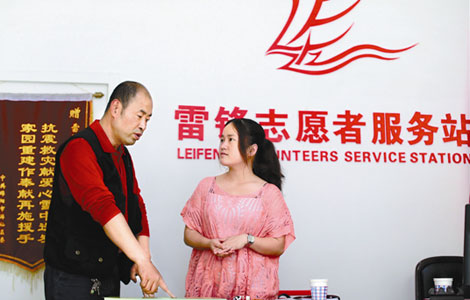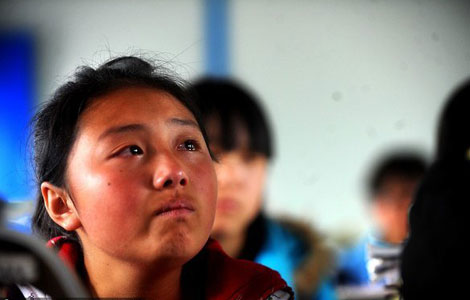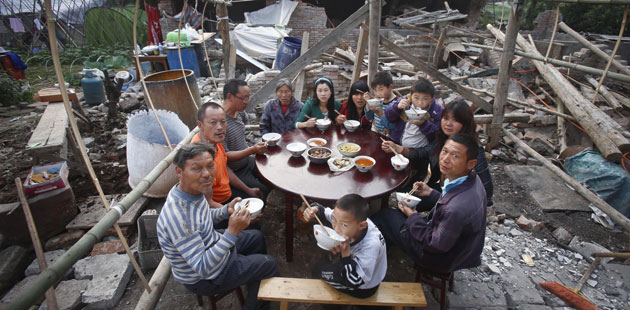Progress in China's human rights
Updated: 2013-05-15 08:03
(China Daily)
|
|||||||||||
People's living standards in poverty-stricken ethnic-minority areas are continuously improving. Based on the actual conditions in ethnic-minority areas, the Chinese government, adhering to the principle of combining assistance from the central government, support from developed regions and self-reliance of the ethnic-minority areas, has formulated a series of preferential policies to promote the ethnic-minority areas' economic growth and improve the living conditions of all ethnic groups. The central government has been continuously increasing transfer payments to ethnic-minority areas. From 2010 to 2012 the total amount of transfer payments to eight ethnic-minority provinces (autonomous regions) reached 2.6055 trillion yuan, up from 24.3 percent to 25.7 percent of the total transfer payments from the central government to local governments. Meanwhile, transfer payments to ethnic-minority autonomous prefectures, counties and border areas have also been increased. The state formulated and promulgated the Plan for Supporting the Development of Ethnic Minority Groups with Fewer Populations (2011-2015), including six ethnic minority groups with populations ranging from 100,000 to 300,000 each in the recipients of assistance, and earmarked special funds to help them develop their economy and improve their production and living conditions. The state also rendered support to the economic and social development of border areas by formulating the Action Plan to Bring Prosperity to Border Areas and the People There (2011-2015). The state adopted policies to increase income for the herdsmen and promote the development of pastoral regions. Marked achievements have been scored in helping ethnic-minority areas and their people get rid of poverty and become relatively well-off. From 2005 to 2010 the number of impoverished people in the eight aforesaid provinces (autonomous regions) decreased from 23.384 million to 13.044 million, and the impoverishment rate dropped from 16.5 percent to 7 percent, nearly 5.5 percentage points faster than the national average impoverishment rate in the same period.
Urban and rural housing conditions are further improved. Since 2009, focusing on the two major themes of "ensuring that all the people enjoy the right to housing" and "obtaining sustainable development of residential areas in the process of urbanization," the Chinese government, while working hard to satisfy the people's diverse demands for housing by promoting market-oriented reform of the urban housing system and developing the commercial housing market, has also listed satisfying the basic housing needs of people in poverty as an important content of the basic public services to be provided by the government and carried out massive affordable housing projects to enhance housing security. The affordable housing projects in China cover the building of affordable housing in urban areas, the rebuilding of shanty areas and rural housing in disrepair, and the building of permanent housing for nomadic herdsmen. From 2008 to 2012 China built more than 18 million affordable suites of housing and rebuilt more than 12 million suites in shanty areas. By the end of 2012 China had provided housing for 31 million urban families, about 12.5 percent of the total urban households. In addition, the government had provided low-rent housing subsidies for nearly 5 million urban low-income families. At the end of 2012 the per-capita living space in China's urban and rural areas reached 32.9 square meters and 37.1 square meters, respectively, up 2.8 square meters and 5.5 square meters compared with 2007. In order to regulate the expropriation of and compensation for buildings on state-owned land, protect the legitimate rights of the owners of such buildings as well as the public interest, the State Council promulgated and put into effect the Regulations on the Expropriation of and Compensation for Buildings on State-owned Land on January 21, 2011, and simultaneously abolished the Regulations on the Dismantling of Urban Houses promulgated on June 13, 2001.
Proactive efforts are made to boost employment. The steady and sustained economic growth has provided a guarantee for employment. The state implements an active employment policy to guarantee the citizens' right to work. From 2008 to 2012 China invested a total of 197.3 billion yuan in special employment funds, and helped 28 million college graduates and 8.3 million people in urban areas with employment difficulties find jobs. In 2012, against a backdrop of slowing economic growth, 12.66 million new job opportunities were created, 5.52 million laid-off workers were reemployed, and 1.82 million people with employment difficulties found jobs in urban areas of China. At the year's end, the registered urban unemployment rate was 4.1 percent, the same as the previous year. The total number of rural migrant workers was 262.61 million in 2012, up 3.9 percent from the previous year, among whom the number of rural workers employed away from their homes reached 163.36 million and the number of local rural workers reached 99.25 million, representing increases of 3 percent and 5.4 percent over the previous year, respectively. As China encourages farmers to find jobs in or close to their hometowns, 85,000 villages launched recreational agriculture and village tourism, providing jobs for 28 million farmers. In 2012 China helped an additional 329,000 disabled people in urban areas to find jobs, raising the total urban number of employed disabled people to 4.448 million; and in the rural areas, 17.703 million disabled people got stable jobs. In 2011, 22 million people took part in vocational training courses of various types provided by the government. In 2012 the central government appropriated 45.4 billion yuan in special employment funds to help implement policies intended to boost employment.
From 2010 to 2012, taking advantage of the training programs of the "Sunlight Project," the Ministry of Agriculture provided agricultural skill training to 9.3 million farmers with 3.3 billion yuan of subsidy funds from the central government.
Related readings:
Human rights protection highlighted in laws amendment
US 'turns blind eye to human rights'
Human rights progress as a matter of fact
Human rights record of the United States in 2012
Related Stories
China protects environment to ensure human rights 2013-05-14 14:32
Human rights protection highlighted in laws amendment 2013-05-14 14:31
China issues white paper on human rights 2013-05-14 11:45
US 'turns blind eye to human rights' 2013-04-22 03:09
Human rights progress as a matter of fact 2013-02-16 08:12
Human rights record of the United States in 2012 2013-04-22 07:25
Today's Top News
Cross-border shopping exodus expected
Manila to apologize for fisherman's death
Sex slave comments anger China
Mystery package prompts consulate closure
Environment vital: white paper
President makes surprise visit to job fair
Measures promised to tackle refinery waste
Migrants need psychological aid
Hot Topics
Lunar probe , China growth forecasts, Emission rules get tougher, China seen through 'colored lens', International board,
Editor's Picks

|

|

|

|

|

|





